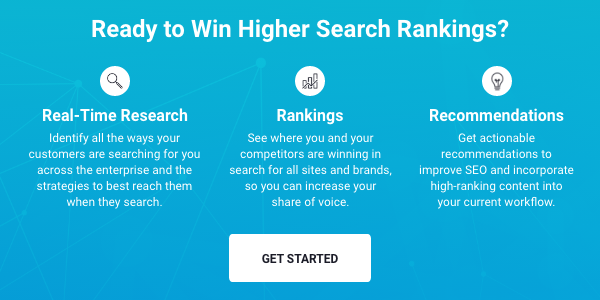Short-Form vs. Long-Form Content: What Do Search Engines Want?
Which is better for ranking in search engines, long or short content? If you’ve been in the search game for more than a minute, you’ll have encountered that question.
Seasoned search engine optimizers (SEOs) would be forgiven for rolling their eyes at this point. It’s a debate that’s raged almost since the advent of search engines like Google.
It would be easy for us here at BrightEdge to give a short answer and declare “case closed.” But we think that the reality is more complex. In fact, we believe that marketers are asking the wrong question.
We’ll explain why thinking in terms of “short vs. long” is misleading. We’ll also show you how to determine the ideal content length for achieving the best possible rankings.
What Is Short Content?
“Short content” typically refers to landing pages, articles and blog posts under 500 words or thereabouts. “Long-form content” is anything above. These parameters aren’t exact or official but are generally recognized as benchmarks by SEOs.
In the past, SEOs have favored long content because it appears to do better in search engines. A handful of studies, many conducted several years ago and with narrow data sets, support this premise.
Examples of long-form content are in-depth how-to articles, editorials, and statistical breakdowns. Short-form content includes recipes, question-and-answer (Q&A) style content, and reviews. Dictionary entries might be thought of as the shortest of short-form content.
Why Longer vs. Shorter Is the Wrong Debate
SEOs tend to favor long-form content because it has statistically performed well in the past and it’s conceived to give you more runway and put in more optimized keywords.
Conclusions about the success of long content are far from definite. But the traditional way of thinking also points toward a deeper misconception about content length—that it’s still a significant ranking factor.
What is certain is that search engines are prioritizing user experience irrespective of content length. Google’s well-known E-A-T criteria (Expertise, Authoritativeness, and Trust), taken from Google’s Search Quality Evaluator Guidelines, don’t mention length.
And the recent “helpful content” update actively devalues long content in certain circumstances. The documentation states: “Are you writing to a particular word count because you've heard or read that Google has a preferred word count? (No, we don't).”
Instead, content length should be determined after evaluating searcher intent. Specifically, there are four factors to consider when deciding on the length of content: the medium of communication (written, video, visual assets, etc.), keyword intent, possible formats for content, and the complexity and depth of the subject being discussed. Let’s take a look at each of these in turn.
1. Don’t Think Exclusively in Terms of Written Content
Before deciding a keyword is best targeted through written content, it’s good practice to consider other potential formats.
Text-based web pages aren’t the only type that ranks well in Google and other search engines. Nor are they always the best way to communicate every kind of information. Google ranks many forms of content, often in conjunction with text-based pages.
Here’s an overview of the main formats, all of which can rank well in search engines:
- Videos and video shorts
- Infographics
- Glossary entries
- White papers
- Reviews
- Graphs and tables
- Webinars
- Case studies
- Checklists
- Research reports
- News reports and press releases
Top content producers typically make use of most of these formats. As a result, they’re able to target customers’ needs directly and flexibly, often seeing rankings right across the board, not just for long-form written content.
BrightEdge’s universal listing tools can be used to monitor a variety of search engine results page (SERP) listings, including featured snippets, videos, images, and news stories. The functionality tracks performance across many content types and helps to create a multifaceted content strategy.
2. Understand Keyword Intent
You should always evaluate keywords through the lens of user intent. If keyword intent mapping isn’t already a part of your content ideation process, you’re almost certainly missing out on the opportunity to provide what your audience is looking for, increasing relevance.
There are three questions to ask to effectively discern intent:
- Which intent category does a keyword fall into? Generally speaking, a keyword phrase will fit into one of three categories: “learn and understand,” “browse and consider,” or “buy and convert.” There are, of course, exceptions to this rule.
- How does your existing content perform? Content on your site that garners high levels of engagement can be useful for determining the intent behind similar keywords to those the content targets.
- What kinds of content already rank well? Existing rankings of competitor sites, when viewed in conjunction with other factors, can be valuable indicators of what search engines value. They provide pointers about which formats to consider and whether or not to create long or short written content.
Understanding intent can significantly affect decisions about length. Individuals searching for recipes, for example, will typically want a straightforward and concise piece of content. Those searching for in-depth how-to guides with accompanying statistical analysis…well, the ideal length of the content should be fairly self-evident.
3. Work Within Existing Structures
There is a general awareness among searchers of different content frameworks—”how to” articles, opinion pieces, glossary entries, etc. As a result, people often look for specific types of articles and web pages. Sometimes, certain keywords will be included in search queries to indicate this.
A robust understanding of different formats is valuable for both meeting intent and determining what the length of a piece of content should be.
For example, opinion pieces usually occupy a middle ground of between 600 and 800 words. Any more, and you run the risk of losing readers’ interest. A recipe, on the other hand, can easily be less than 200 words while fulfilling its function perfectly.
Ensure that your content team is familiar with the following content types:
- Opinion pieces
- News pieces
- Product landing pages
- How to guides
- List-based posts (or listicles)
- Reviews
- Comparison articles (like Pixel vs. iPhone)
- Recipes
- Definitions and glossary entries
- Graphs and visual content
This isn’t an exhaustive list but should provide a basis for thinking about what users are looking for. Ensuring proficiency with different frameworks in your content team is one of the surest ways to guarantee that length doesn’t become an arbitrary SEO target.
More organizations are adopting a democratized SEO model, in which previously siloed departments are expected to collaborate to meet key performance indicators (KPIs). The SEO/Growth team should consider working with content creators to establish an understanding of the different content types outlined above to find the appropriate way to work optimization into the fold.
4. Leverage Long-Form Content for Complex Topics
It’s worth stating in strong terms that long content is not bad. That isn’t the message that we’re trying to put across. It’s simply a weapon that needs to be wielded intelligently.
In particular, there is a lingering myth in the SEO industry that creating dedicated pages for keywords increases the likelihood of ranking for them.
This isn’t the case, particularly with Google’s on-site Chrome highlighting function (Quick Focus Highlight), along with featured snippets, that take searchers directly to the relevant section of a web page.
Data from BrightEdge suggests it is better to use sub-keywords intelligently as part of a longer piece of content than to create lots of shorter articles. Determine whether or not keywords should form a separate page or a subsection of a longer one by a detailed evaluation of both user intent and the performance of your existing web pages.
Ultimately, you should structure long-form content with coherent headlines that match searcher questions, include media and space to break up walls of text, thereby improving readability, and be sure to match the length of what you think would be appropriate for a reader to digest.
Conclusion
The long vs. short debate is the wrong paradigm through which to look at content. Instead, SEOs should focus on user intent and an impartial analysis of text-based web pages that already perform well.
For example, if you want to buy Nike shoes, you don’t need a 2,000-word block of text that explains the features and history of your preferred pair. Similarly, if you are researching fishing rods, you might require some FAQ guidance and reviews to help guide you, but will likely avoid overly long pages.
It is clear that search engines like Google don’t equate length with quality. Before you start making word requirements for your content creation process, think about what your audience is looking to do with that content and make sure you match their intent.
More Resources
What is Keyword Search Intent?
The Democratization of SEO: A Practical Guide
9 Tips for Bulletproof SEO: Algorithm-Proof Your SEO Strategy


